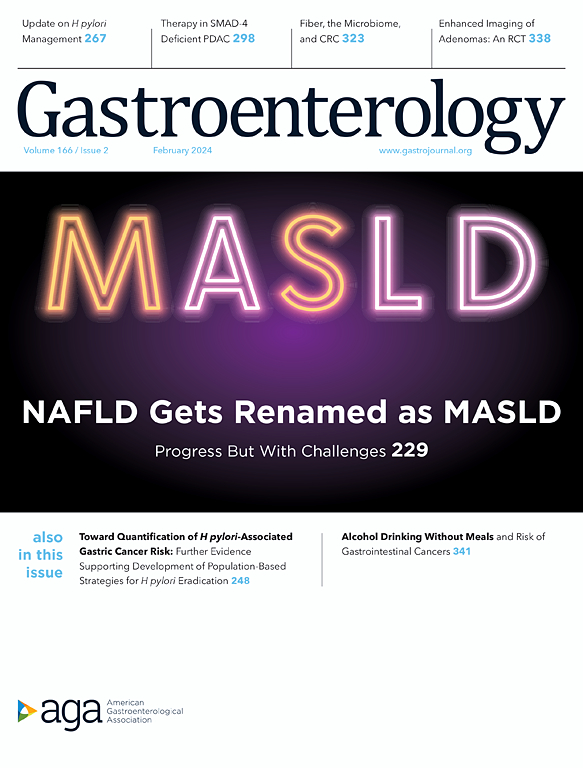三个前瞻性中老年人群的饮食模式和慢性便秘发生率
IF 25.7
1区 医学
Q1 GASTROENTEROLOGY & HEPATOLOGY
引用次数: 0
摘要
背景和目的目前关于饮食与便秘关联的文献受限于小样本量和横断面设计。我们的目的是全面检查五种饮食模式及其组成与便秘之间的关系。方法在护士健康研究(NHS), NHSII和健康专业随访研究(HPFS)三个大型队列中,我们根据过去一年中反复测量的自述便秘症状≥12周来确定慢性便秘。我们评估了五种饮食模式(地中海替代饮食(aMED)、低碳水化合物饮食(LCD)、西方饮食(WD))和指数(植物性饮食指数(PDI)、经验性饮食炎症模式(EDIP))的长期依从性,采用四年一次的有效食物频率问卷。我们使用对数二项模型对多种混杂因素进行调整,包括纤维或超加工食品(UPF)摄入量,以估计便秘的相对风险(95%置信区间)。结果在27774名(78.4±5.6岁)NHS、55906名(60.5±4.6岁)NHSII和12237名(78.6±5.6岁)HPFS参与者的合并队列中,经过2-4年的随访,我们记录了7519例便秘病例。与最低的五分之一相比,阿米德和PDI的前五分之一与便秘风险降低16%(9-22%)和20%(14-27%)相关,而EDIP、WD和LCD的前五分之一分别与便秘风险增加24%(15-33%)、22%(11-33%)和3%(-3-11%)相关。这些关联与总纤维或UPF摄入量无关。摄入富含aMED和PDI的蔬菜和坚果有助于降低便秘风险。结论强调植物性食物和健康脂肪的饮食模式可以预防便秘,为未来的饮食干预和慢性便秘的治疗提供信息。本文章由计算机程序翻译,如有差异,请以英文原文为准。

Dietary Patterns and Incident Chronic Constipation in Three Prospective Cohorts of Middle- and Older-aged Adults
Background and Aims
Current literature on diet-constipation associations is limited by small sample sizes and cross-sectional designs. We aimed to comprehensively examine the associations between five dietary patterns, their components, and incident constipation.Methods
In three large cohorts, the Nurses’ Health Study (NHS), NHSII, and the Health Professional Follow-up Study (HPFS), we identified chronic constipation based on repeatedly-measured self-reported constipation symptoms for ≥12 weeks in the past year. We assessed long-term adherence to five dietary patterns (alternate Mediterranean diet (aMED), low-carbohydrate diet (LCD), Western diet (WD)) and indices (plant-based dietary index (PDI), empirical dietary inflammatory pattern (EDIP)) using validated quadrennial food frequency questionnaires. We used a log-binomial model adjusted for a wide range of confounders, including fiber or ultra-processed food (UPF) intake, to estimate relative risk (95% confidence interval) for constipation.Results
In the pooled cohort of 27,774 (78.4±5.6y) NHS, 55,906 (60.5±4.6y) NHSII, and 12,237 (78.6±5.6y) HPFS participants, we documented 7,519 incident constipation cases after 2-4 years of follow-up. Compared to the lowest quintiles, the top quintiles of aMED and PDI were associated with 16% (9-22%) and 20% (14-27%) reduced risk for constipation, whereas the top quintiles of EDIP, WD, and LCD were associated with 24% (15-33%), 22% (11-33%), and 3% (-3-11%) increased risk for constipation, respectively. These associations were independent of total fiber or UPF intake. Vegetable and nut intake, which are enriched in aMED and PDI, were associated with decreased constipation risks.Conclusion
Our findings suggest that dietary patterns emphasizing plant-based foods and healthy fats may protect against constipation, informing future dietary interventions and treatments for chronic constipation.求助全文
通过发布文献求助,成功后即可免费获取论文全文。
去求助
来源期刊

Gastroenterology
医学-胃肠肝病学
CiteScore
45.60
自引率
2.40%
发文量
4366
审稿时长
26 days
期刊介绍:
Gastroenterology is the most prominent journal in the field of gastrointestinal disease. It is the flagship journal of the American Gastroenterological Association and delivers authoritative coverage of clinical, translational, and basic studies of all aspects of the digestive system, including the liver and pancreas, as well as nutrition.
Some regular features of Gastroenterology include original research studies by leading authorities, comprehensive reviews and perspectives on important topics in adult and pediatric gastroenterology and hepatology. The journal also includes features such as editorials, correspondence, and commentaries, as well as special sections like "Mentoring, Education and Training Corner," "Diversity, Equity and Inclusion in GI," "Gastro Digest," "Gastro Curbside Consult," and "Gastro Grand Rounds."
Gastroenterology also provides digital media materials such as videos and "GI Rapid Reel" animations. It is abstracted and indexed in various databases including Scopus, Biological Abstracts, Current Contents, Embase, Nutrition Abstracts, Chemical Abstracts, Current Awareness in Biological Sciences, PubMed/Medline, and the Science Citation Index.
 求助内容:
求助内容: 应助结果提醒方式:
应助结果提醒方式:


